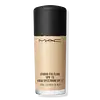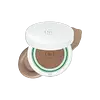What's inside
What's inside
 Key Ingredients
Key Ingredients

 Benefits
Benefits

 Concerns
Concerns

 Ingredients Side-by-side
Ingredients Side-by-side

Ethylhexyl Methoxycinnamate 2.5%
UV AbsorberTitanium Dioxide 1%
Cosmetic ColorantWater
Skin ConditioningCyclopentasiloxane
EmollientPEG-10 Dimethicone
Skin ConditioningButylene Glycol
HumectantTrimethylsiloxysilicate
EmollientDimethicone
EmollientMagnesium Sulfate
Laminaria Saccharina Extract
Skin ProtectingAlgae Extract
EmollientTocopheryl Acetate
AntioxidantSodium Hyaluronate
HumectantTocopherol
AntioxidantLecithin
EmollientHydrogenated Lecithin
EmulsifyingXanthan Gum
EmulsifyingSorbitan Sesquioleate
EmulsifyingMethoxy Amodimethicone/Silsesquioxane Copolymer
Skin ConditioningLaureth-7
EmulsifyingDipropylene Glycol
HumectantDimethicone/PEG-10/15 Crosspolymer
Dimethicone/PEG-10 Crosspolymer
EmollientPEG/PPG-18/18 Dimethicone
EmulsifyingDisteardimonium Hectorite
StabilisingSilica
AbrasiveDimethicone Crosspolymer
Emulsion StabilisingTriethoxycaprylylsilane
Propylene Carbonate
SolventPentaerythrityl Tetra-Di-T-Butyl Hydroxyhydrocinnamate
AntioxidantSorbic Acid
PreservativeChloroxylenol
AntimicrobialPhenoxyethanol
PreservativeCI 77891
Cosmetic ColorantIron Oxides
CI 77288
Cosmetic ColorantEthylhexyl Methoxycinnamate 2.5%, Titanium Dioxide 1%, Water, Cyclopentasiloxane, PEG-10 Dimethicone, Butylene Glycol, Trimethylsiloxysilicate, Dimethicone, Magnesium Sulfate, Laminaria Saccharina Extract, Algae Extract, Tocopheryl Acetate, Sodium Hyaluronate, Tocopherol, Lecithin, Hydrogenated Lecithin, Xanthan Gum, Sorbitan Sesquioleate, Methoxy Amodimethicone/Silsesquioxane Copolymer, Laureth-7, Dipropylene Glycol, Dimethicone/PEG-10/15 Crosspolymer, Dimethicone/PEG-10 Crosspolymer, PEG/PPG-18/18 Dimethicone, Disteardimonium Hectorite, Silica, Dimethicone Crosspolymer, Triethoxycaprylylsilane, Propylene Carbonate, Pentaerythrityl Tetra-Di-T-Butyl Hydroxyhydrocinnamate, Sorbic Acid, Chloroxylenol, Phenoxyethanol, CI 77891, Iron Oxides, CI 77288
Water
Skin ConditioningTitanium Dioxide
Cosmetic ColorantMethyl Trimethicone
Skin ConditioningCaprylic/Capric Triglyceride
MaskingCetyl Ethylhexanoate
EmollientZinc Oxide
Cosmetic ColorantHydrogenated Polyisobutene
EmollientPolyglyceryl-3 Polydimethylsiloxyethyl Dimethicone
Skin ConditioningPhenyl Trimethicone
Skin ConditioningSilica
AbrasiveLauryl Polyglyceryl-3 Polydimethylsiloxyethyl Dimethicone
Skin ConditioningNiacinamide
SmoothingButylene Glycol
HumectantGlycerin
HumectantSorbitan Sesquioleate
EmulsifyingCentella Asiatica Extract
CleansingDiphenyl Dimethicone
EmollientSodium Chloride
MaskingStearalkonium Hectorite
Gel Forming1,2-Hexanediol
Skin ConditioningAluminum Hydroxide
EmollientPolypropylsilsesquioxane
Dextrin Palmitate
EmulsifyingTrimethylsiloxysilicate
EmollientSorbitan Isostearate
EmulsifyingTriethoxycaprylylsilane
Stearic Acid
CleansingPropylene Carbonate
SolventCaprylyl Glycol
EmollientTocopherol
AntioxidantAdenosine
Skin ConditioningEthylhexylglycerin
Skin ConditioningSodium Hyaluronate
HumectantMica
Cosmetic ColorantCI 77492
Cosmetic ColorantCI 77491
Cosmetic ColorantCI 77499
Cosmetic ColorantWater, Titanium Dioxide, Methyl Trimethicone, Caprylic/Capric Triglyceride, Cetyl Ethylhexanoate, Zinc Oxide, Hydrogenated Polyisobutene, Polyglyceryl-3 Polydimethylsiloxyethyl Dimethicone, Phenyl Trimethicone, Silica, Lauryl Polyglyceryl-3 Polydimethylsiloxyethyl Dimethicone, Niacinamide, Butylene Glycol, Glycerin, Sorbitan Sesquioleate, Centella Asiatica Extract, Diphenyl Dimethicone, Sodium Chloride, Stearalkonium Hectorite, 1,2-Hexanediol, Aluminum Hydroxide, Polypropylsilsesquioxane, Dextrin Palmitate, Trimethylsiloxysilicate, Sorbitan Isostearate, Triethoxycaprylylsilane, Stearic Acid, Propylene Carbonate, Caprylyl Glycol, Tocopherol, Adenosine, Ethylhexylglycerin, Sodium Hyaluronate, Mica, CI 77492, CI 77491, CI 77499
 Reviews
Reviews

Ingredients Explained
These ingredients are found in both products.
Ingredients higher up in an ingredient list are typically present in a larger amount.
Butylene Glycol (or BG) is used within cosmetic products for a few different reasons:
Overall, Butylene Glycol is a safe and well-rounded ingredient that works well with other ingredients.
Though this ingredient works well with most skin types, some people with sensitive skin may experience a reaction such as allergic rashes, closed comedones, or itchiness.
Learn more about Butylene GlycolThis ingredient is a solvent. It helps dissolve active ingredients and alter the texture of products.
Propylene Carbonate is commonly used in makeup and with clay, such as montmorillonite or bentonite.
Studies show this ingredient to be safe for cosmetics. When it is undiluted, it can cause skin irritation. (It is always diluted in skincare and makeup). This ingredient is water-soluble.
Propylene Carbonate is created from propylene glycol and carbonic acid.
Learn more about Propylene CarbonateSilica, also known as silicon dioxide, is a naturally occurring mineral. It is used as a fine, spherical, and porous powder in cosmetics.
Though it has exfoliant properties, the function of silica varies depending on the product.
The unique structure of silica enhances the spreadability and adds smoothness, making it a great texture enhancer.
It is also used as an active carrier, emulsifier, and mattifier due to its ability to absorb excess oil.
In some products, tiny microneedles called spicules are made from silica or hydrolyzed sponge. When you rub them in, they lightly polish away dead skin layers and enhance the penetration of active ingredients.
Learn more about SilicaSodium Hyaluronate is hyaluronic acid's salt form. It is commonly derived from the sodium salt of hyaluronic acid.
Like hyaluronic acid, it is great at holding water and acts as a humectant. This makes it a great skin hydrating ingredient.
Sodium Hyaluronate is naturally occurring in our bodies and is mostly found in eye fluid and joints.
These are some other common types of Hyaluronic Acid:
Learn more about Sodium HyaluronateSorbitan Sesquioleate is derived from sorbitol and oleic acid. It is an emulsifier and prevents ingredients from separating.
Specifically, this ingredient is a water-in-oil emulsifier, meaning it helps water dissolve into oil.
Some studies suggest this ingredient may cause irritation in some people. If you are unsure, it is best to patch test.
This ingredient may not be Malassezia folliculitis, or fungal-acne safe.
Learn more about Sorbitan SesquioleateTitanium dioxide is a mineral UV filter widely used in sunscreens and cosmetics.
It is one of only two UV filters officially classified as “mineral” by regulatory agencies, the other being zinc oxide.
Titanium dioxide provides broad-spectrum protection mostly in the UVB and UVAII range, with some protection in the UVAI range.
While its UVA protection isn’t as strong as zinc oxide’s, the difference is minor.
A common myth is that mineral UV filters reflect UV light. However, modern research shows titanium dioxide absorbs UV radiation like chemical filters (~95% absorption & 5% reflection).
Thanks to its non-irritating nature, titanium dioxide is suitable for sensitive, acne-prone, or redness-prone skin. It is unlikely to cause "eye sting" like other sunscreen ingredients.
A major drawback of this ingredient is its white cast and thick texture. This is why mineral sunscreens often leave a white cast and are less cosmetically elegant than chemical/hybrid sunscreens.
To improve white cast and spreadability, micronized or nano-sized titanium dioxide is often used.
There are ongoing concerns surrounding nano-titanium oxide's impact on marine ecosystems.
There is no conclusive evidence that any form of titanium oxide (or any other sunscreen ingredients) will cause harm to marine ecosystems or coral reefs. The science is still developing but many consumers are keeping a close eye on this issue.
Please note, many destinations have reef-safety sunscreen rules. For instance, the U.S. Virgin Islands advises all visitors to use non-nano mineral sunscreens.
Nano mineral sunscreens once raised safety concerns about absorption into skin.
Extensive research has shown that they do not penetrate healthy or damaged skin; they remain safely on the surface and the top layer of dead skin (stratum corneum).
You'll likely find titanium dioxide bundled with alumina, silica, or dimethicone. These ingredients help make titanium dioxide highly photostable; this prevents it from interacting with other formula components under UV light.
Learn more about Titanium DioxideTocopherol (also known as Vitamin E) is a common antioxidant used to help protect the skin from free-radicals and strengthen the skin barrier. It's also fat soluble - this means our skin is great at absorbing it.
Vitamin E also helps keep your natural skin lipids healthy. Your lipid skin barrier naturally consists of lipids, ceramides, and fatty acids. Vitamin E offers extra protection for your skin’s lipid barrier, keeping your skin healthy and nourished.
Another benefit is a bit of UV protection. Vitamin E helps reduce the damage caused by UVB rays. (It should not replace your sunscreen). Combining it with Vitamin C can decrease sunburned cells and hyperpigmentation after UV exposure.
You might have noticed Vitamin E + C often paired together. This is because it is great at stabilizing Vitamin C. Using the two together helps increase the effectiveness of both ingredients.
There are often claims that Vitamin E can reduce/prevent scarring, but these claims haven't been confirmed by scientific research.
Learn more about TocopherolTriethoxycaprylylsilane is a silicone used to bind and stabilize ingredients.
As an emulsifier, it helps prevent ingredients from separating. This can help elongate the shelf life of products.
Triethoxycaprylylsilane is often used to coat mineral sunscreens ingredients to help give a better feel. It also helps reduce oxidative stress in sunscreens.
Learn more about TriethoxycaprylylsilaneThis silicone is an emollient. Emollients create a thin film on the skin to prevent moisture from escaping.
It is not soluble in water and helps increase water-resistance in products.
According to a manufacturer, it can blend seamlessly with silicone oils, such as Cyclopentasiloxane.
Learn more about TrimethylsiloxysilicateWater. It's the most common cosmetic ingredient of all. You'll usually see it at the top of ingredient lists, meaning that it makes up the largest part of the product.
So why is it so popular? Water most often acts as a solvent - this means that it helps dissolve other ingredients into the formulation.
You'll also recognize water as that liquid we all need to stay alive. If you see this, drink a glass of water. Stay hydrated!
Learn more about Water